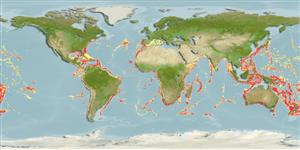Common names from other countries
Classification / Names / Names
Namen | Synonyme | Catalog of Fishes (gen., sp.) | ITIS | CoL | WoRMS
Environment: milieu / climate zone / depth range / distribution range
Ökologie
; tiefenbereich 274 - 1850 m (Ref. 101581), usually 400 - 900 m (Ref. 8). Tropical, preferred 25°C (Ref. 107945); 43°N - 48°S, 97°W - 138°W (Ref. 113739)
Circumglobal in tropical to temperate waters.
Length at first maturity / Size / Gewicht / Alter
Maturity: Lm ? range ? - ? cm Max length : 19.3 cm TL Männchen/unbestimmt; (Ref. 8); 33.4 cm TL (female)
Commercially fished in the Atlantic (Senegal, Guinea, Congo, Angola, and French Guyana) (Ref. 8), but no longer in Brazil (Ref. 101581). Benthic (Ref. 91956). Predominantly deep-water species (Ref. 104150). Found on muddy bottom. Temperate to tropical environment (Ref. 8). Feeds on crustaceans, sediment, fishes, cephalopods, anthozoans, polychaetes and echinoderms (Ref. 104150).
Life cycle and mating behavior
Geschlechtsreife | Fortpflanzung | Ablaichen | Eier | Fecundity | Larven
Members of the order Decapoda are mostly gonochoric. Mating behavior: Precopulatory courtship ritual is common (through olfactory and tactile cues); usually indirect sperm transfer.
Holthuis, L.B. 1980. (Ref. 8)
IUCN Rote Liste Status (Ref. 130435)
CITES Status (Ref. 108899)
Not Evaluated
Not Evaluated
Nutzung durch Menschen
Fischereien: kommerziell
| FishSource | Sea Around Us
Tools
Internet Quellen
Estimates based on models
Preferred temperature
(Ref.
115969): 3.7 - 12.6, mean 7.4 (based on 1390 cells).
Verwundbarkeit
Low vulnerability (10 of 100).
